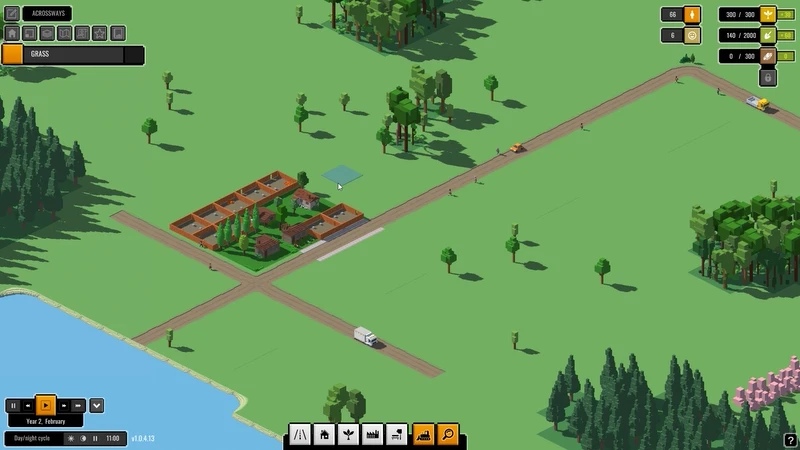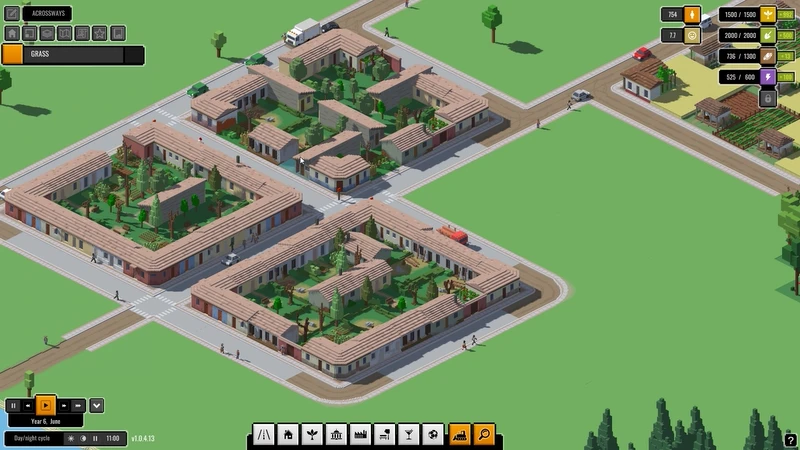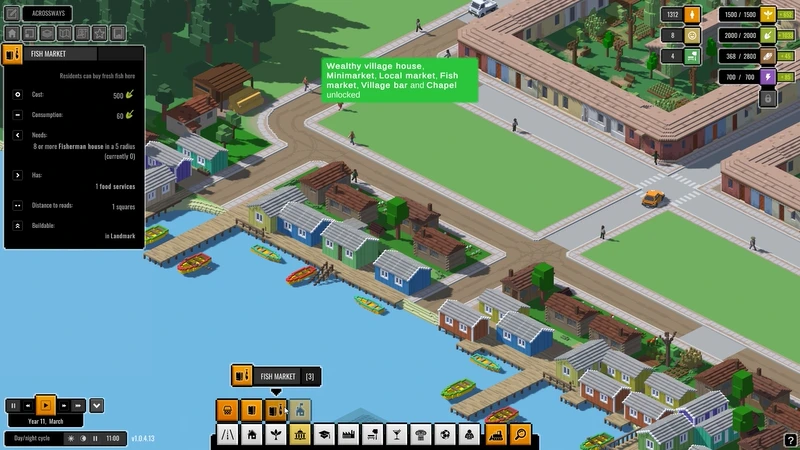Toggle Background Color

Hello everyone! This update is gonna be a little weird, not the least reason being because it starts with a GeForce Experience banner. The game I'm showing off for this liminal update doesn't play well with Shadowplay, so I had to go and enable the cursed "record desktop" option.

But the game itself is really good, so I don't mind. This is Urbek City Builder and it basically came out of nowhere last year. I just picked it up the other day and knew instantly it was the perfect game to demonstrate while C:S languishes in mod hell.
If I'm being honest, the mods are probably as updated as they're going to get. But sssh, let me have this. This game is adorable and I love it.

We're going to start a new city here just to poke around a bit. Truth be told, I have yet to unlock any of the other biomes. But the temperate biome is good enough for me.

"Hey Steve, where are you going today?" "Acrossways."

Larger map sizes are easier because you have more room to build on. And higher density resources are easier because there's more to deplete. Most of my options are left at default. I like a good coastline on the map and a river is a fun obstacle to build around.

Looks like the river bisects the map on the right center. The pink whatsits are iron ore deposits.

Lots of good room to build on the west side of the river. And the coast is to the south.

Urbek is a game about resource management. But, critically, money is not one of those resources. To start out with, we need to balance five resources.
Person Icon: Population.
Yellow Plant: Food. If we're running a deficit, no buildings will grow or evolve until we fix it.
Smiley Face: Happiness. Arguably the least important one starting off. It only governs a few unlocks that I've seen.
Shovel: Production capacity. This is what keeps you expanding. The only way to generate more is to build houses. Being at a deficit of this sucks because everything grinds to a halt until you can fix it.
Brown Block: Wood. We need this for a lot of stuff, especially early-game.

So lets toss down a few roads...

Off to the north is where I'm gonna lay down farm fields.

Here we can see that each individual farm field costs 30 production, continually produces 14 food, and drains 5 overall production. It also needs to be within 5 squares of a road to function. So by placing one, we'll be down to 1970 production and will be running -5 per tick. It's not a huge issue, but it's important to keep in mind while expanding. Urbek is not a game where you want to pave vast swathes of the landscape willy nilly.

A 6x5 field is good to start with.

Right away you can see that we're now making 56 food/tick, and we're gaining 5 production/tick. Why gaining? Take a look at the color on the +5 - it's red. That means our production is so far in the negative that the game is giving us a pity +5 to claw ourselves back up out of the hole we've suddenly found ourselves in. Yikes. So let's get to building some houses while we have resources to do so.

A 4x5 grid of houses here. We're down to 105 production. Each housing plot takes 50 to lay down. Time to wait.

Houses, by the way, need 50 production and 10 wood. Each basic plot produces 10 production and consumes 10 food. It also needs to be built within 3 squares of a road. It can also evolve, but more on that in a minute. Keeping it simple right now.


I'm not gonna keep showing this every time I make a change, but I do want to hammer home how every little action you take affects your resources. You have to be constantly monitoring them. This game is a continual balancing act. We've also run out of wood, which we kind of need to make more houses. So let's fix that.

We need proximity to trees, so let's drag a road out next to this dense forest to the west...

You don't need me to walk you through reading this now. The only new information is "stores" which means this lumber camp increases our global wood capacity by 500 per camp. Handy! Also we can't place lumber camps next to each other. Each one needs to be alone in a radius of 5 tiles. That's something a lot of buildings will mandate, and keeping that in mind as you build out is half the 'puzzle'.

The game likes to bitch if you do things out of order. Here, I built the forest road first and connected it second. Now it has angry little red exclamation marks because has to make its displeasure known that I did things out of its expected order.

We can still sneak two in along this single road. They are exactly five tiles apart! Now while we wait for wood to tick in, let me show something else off...

You can hover the mouse over any resource to see a breakdown of what is consuming it. We're about to dip into the negative again.

Early on the game will also ask you to pick one of three 'paths' - these affect the goals for the city. The path to wealth involves catering to upper-class townies, the path of productivity involves getting down and dirty with industry, while the path of leisure wants you to build lots of parks and nightlife.
It's very easy to get in the path of productivity by just trying to scale up your resource production. I did it by accident in my last game. The path of leisure requires building a lot of parks - a building we don't even have unlocked yet. The path to wealth just needs to build four villas, estates by any other name. We'll be pursuing the path to wealth in this short demonstration.
We can't build villas yet. They need 800 population to unlock and we're still struggling to get 100. So this is a lot of forward thinking that doesn't really matter for the time being.

One last thing I really like is that you can go down to a street-level view at any time and just wander around your city. Here you will probably notice that everything is built from voxels. It's a very Minecraftian look, but that's not a bad thing at all.

Strict gridding is very easy to do, but just breaking up the block sizes keeps things visually interesting. You really don't want to make blocks bigger than 6 wide or tall. Any more than that, and the properties in the middle won't develop.

And while filling in the blocks, we get our first unlock. A very important one, too!

Farm houses produce a lot of food, act as important food storage, and are a requirement for a lot of later buildings. They also have some pretty strict requirements themselves. Each house needs to be 5 squares apart and needs at least 12 farm tiles in a 3-square radius.

And look at that, our 5x6 field size is juuuust big enough that we can have a single farm house per "lot" of field.



More expansion...

Taking a look at one of our many wooden huts, the first upgrade - the village house - needs 300 population and 3 farm houses. That's not per. That's a global unlock. So once we have that, the huts can evolve to village houses at any time. So we have a second goal!

We already have over 400 population, so placing that farm house did the trick. Or it should have buuut...


The lumberjack cabin is something of a mandate. I'm sure you can make an educated guess what that purple lightning bolt means.

I put two of them down between the two lumber camps, and just for good measure, dropped a few houses. That's a requirement for the lumberjack house, a building mentioned in the last tooltip.

Also we unlocked tenant farmers. That's basically feudal farm serfs. It's a nasty practice, but it's hilariously efficient for farming to the point where a field of tenants will out-produce the entire field they're working. Just look at those numbers. 50 production and 50 storage. The field I'm building them on produces 14 and stores 0.

Eight tenant shacks on the field...


The overseer's house nearby...

One field of them is producing more than 38% of the total amount of food we're making altogether.

And while we're at it, some more tooltips to make your eyes slide right off the image. These are the new houses that have popped up now that we're offering such modern innovations like electricity.
A new "need" has also cropped up. "15 or more squares with at least 6 residents in a 3 radius (currently 29)" is very descriptive, but it's the sort of sentence you see in a math textbook that makes your brain slide right off. The simplest way to put it is density. Higher tiers of houses need density. So houses on the edges of your city will be less developed than ones in the middle of downtown. This makes Urbek one of the only city building games I've ever played to accurately model density tapering off the closer you get to the city limits.
Nicer houses also can't develop in polluted areas. It's just something to keep in mind, especially in heavily industrialized cities.

The village houses in question, by the way. They look pretty nice if I do say so myself.

Their upgrade has a few requirements. We need "food service" and "leisure" nearby, as well as 1300 total population. They offer the same benefits as the regular village house, but they're a necessary stepping stone to better homes. They also just look nicer. We'll see them eventually.

We're almost at 800 population, so let's get started on the path of wealth.

Villas need a park immediately nearby and four squares of clearance from the nearest source of population.

Come 800, that'll be 2 of the 4 villas we need.

Speak of the devil! This isn't all that different from designing a nobility quarter in Emperor: Rise of the Middle Kingdom. Except you don't have to offer most of the goods your city produces in the local market. Indeed, they don't even need a local market.

Each lumber camp contributes 15 wood production. So if you place six down before you do anything else, you're on the path of productivity. Keep that in mind.

After some more expansion, we unlock two new buildings. The windmill is actually a modded building! It produces a little food and a little electricity at the cost of wood upkeep.

I like the way they look.

Here's that tooltip, but bigger. You can't place them right next to each other, but you can place them one square apart. 250 wood per mill is a big pinch, especially with each one taking 2 in upkeep. We'll have to build more lumber camps soon.

But first... :sickos: I've been waiting for this.

Docks also produce food. I'm sure you can guess which type. But that's not all!

Houses near docks, while also being on the shore, evolve into fisherman houses! It actually creates a little wharf area on your shoreline.

I also go ahead and set down the other two villas so we can get started on our objectives.

This is actually pretty easily doable. We just need to bring a higher standard of living to the city. We want to do this anyway just to keep progressing. So this is basically a free milestone!

We hit another population threshold and get a bunch of things unlocked. It looks like we just crept over 1300.

This is what I'm really excited for. 1300 population means we can set up little neighborhood markets. A waterfront neighborhood like we have can build fish markets nearby, which do the same thing. Why is this important? Because the regular mini markets cost 200 food upkeep!

Wealthy village houses also need leisure nearby. So...

How about a spot to drink?

A peek, by the way, at how the city is doing. The new icon is tracking parks and leisure in the city. There's 4 because each villa needs one nearby. Unlike in Skylines, parks in this game cost production upkeep to maintain. So you don't want to go hog wild with them. That +1243 doesn't go as far as you'd want it to.

The farm equivalent of the fish market is the local market. It just requires 60 production upkeep, which is better than the 200 for its "place anywhere" counterpart.

I also slap down one of these near the farms just to offer some variety. We'll want three of these anyway to unlock tennis courts. Also this game is by Chilean developers, so it's using the rest-of-the-world definition of football. Granted you could probably guess that by looking at the icon.

Blown up for your convenience.

The northern half of the city is still developing, but you can see the color change for the wealthy houses down in the harbor area. And I also think that's a pretty good spot to call it for now!
Next time we'll be leading Acrossways through its first tentative steps into heavy industry. See you then!

































































